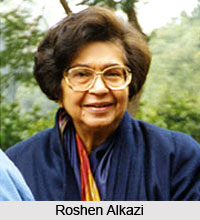 Roshen Alkazi was one of the few Indian costumiers for whom the art is a serious, passionate venture to recreate a particular period accurately on stage or screen. This charismatic personality was born in Bombay, she studied costume at the Victoria and Albert Museum, London. She married Ebrahim Alkazi and was actively associated with his work in Bombay and New Delhi, designing costumes in more than seventy productions for Theatre Group and Theatre Unit in Bombay and then for the National School of Drama. Her range covered Shakespeare`s King Lear and Othello, Buechner`s Danton`s Death and Shanta Gandhi`s Jasma Odan. She taught the history of costume at the New Delhi Polytechnic for several years. Also an authority on jewellery, headgear, and hairstyles in ancient India, she published Ancient Indian Costume, an extensively illustrated and monumental volume based on her study and practical knowledge of the subject. She is now researching medieval Indian costume. She has written books of poetry and has been director of Art Heritage, a contemporary art gallery in New Delhi, over a long period.
Roshen Alkazi was one of the few Indian costumiers for whom the art is a serious, passionate venture to recreate a particular period accurately on stage or screen. This charismatic personality was born in Bombay, she studied costume at the Victoria and Albert Museum, London. She married Ebrahim Alkazi and was actively associated with his work in Bombay and New Delhi, designing costumes in more than seventy productions for Theatre Group and Theatre Unit in Bombay and then for the National School of Drama. Her range covered Shakespeare`s King Lear and Othello, Buechner`s Danton`s Death and Shanta Gandhi`s Jasma Odan. She taught the history of costume at the New Delhi Polytechnic for several years. Also an authority on jewellery, headgear, and hairstyles in ancient India, she published Ancient Indian Costume, an extensively illustrated and monumental volume based on her study and practical knowledge of the subject. She is now researching medieval Indian costume. She has written books of poetry and has been director of Art Heritage, a contemporary art gallery in New Delhi, over a long period.




















